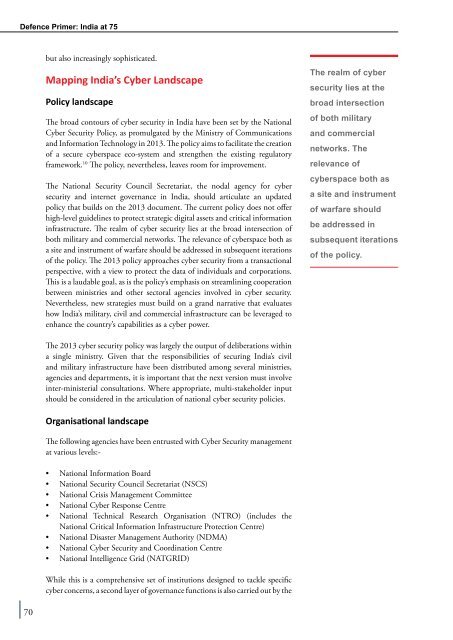Defence Primer
Military_Layout
Military_Layout
Create successful ePaper yourself
Turn your PDF publications into a flip-book with our unique Google optimized e-Paper software.
<strong>Defence</strong> <strong>Primer</strong>: India at 75<br />
but also increasingly sophisticated.<br />
Mapping India’s Cyber Landscape<br />
Policy landscape<br />
The broad contours of cyber security in India have been set by the National<br />
Cyber Security Policy, as promulgated by the Ministry of Communications<br />
and Information Technology in 2013. The policy aims to facilitate the creation<br />
of a secure cyberspace eco-system and strengthen the existing regulatory<br />
framework. 10 The policy, nevertheless, leaves room for improvement.<br />
The National Security Council Secretariat, the nodal agency for cyber<br />
security and internet governance in India, should articulate an updated<br />
policy that builds on the 2013 document. The current policy does not offer<br />
high-level guidelines to protect strategic digital assets and critical information<br />
infrastructure. The realm of cyber security lies at the broad intersection of<br />
both military and commercial networks. The relevance of cyberspace both as<br />
a site and instrument of warfare should be addressed in subsequent iterations<br />
of the policy. The 2013 policy approaches cyber security from a transactional<br />
perspective, with a view to protect the data of individuals and corporations.<br />
This is a laudable goal, as is the policy’s emphasis on streamlining cooperation<br />
between ministries and other sectoral agencies involved in cyber security.<br />
Nevertheless, new strategies must build on a grand narrative that evaluates<br />
how India’s military, civil and commercial infrastructure can be leveraged to<br />
enhance the country’s capabilities as a cyber power.<br />
The realm of cyber<br />
security lies at the<br />
broad intersection<br />
of both military<br />
and commercial<br />
networks. The<br />
relevance of<br />
cyberspace both as<br />
a site and instrument<br />
of warfare should<br />
be addressed in<br />
subsequent iterations<br />
of the policy.<br />
The 2013 cyber security policy was largely the output of deliberations within<br />
a single ministry. Given that the responsibilities of securing India’s civil<br />
and military infrastructure have been distributed among several ministries,<br />
agencies and departments, it is important that the next version must involve<br />
inter-ministerial consultations. Where appropriate, multi-stakeholder input<br />
should be considered in the articulation of national cyber security policies.<br />
Organisational landscape<br />
The following agencies have been entrusted with Cyber Security management<br />
at various levels:-<br />
• National Information Board<br />
• National Security Council Secretariat (NSCS)<br />
• National Crisis Management Committee<br />
• National Cyber Response Centre<br />
• National Technical Research Organisation (NTRO) (includes the<br />
National Critical Information Infrastructure Protection Centre)<br />
• National Disaster Management Authority (NDMA)<br />
• National Cyber Security and Coordination Centre<br />
• National Intelligence Grid (NATGRID)<br />
While this is a comprehensive set of institutions designed to tackle specific<br />
cyber concerns, a second layer of governance functions is also carried out by the<br />
70


